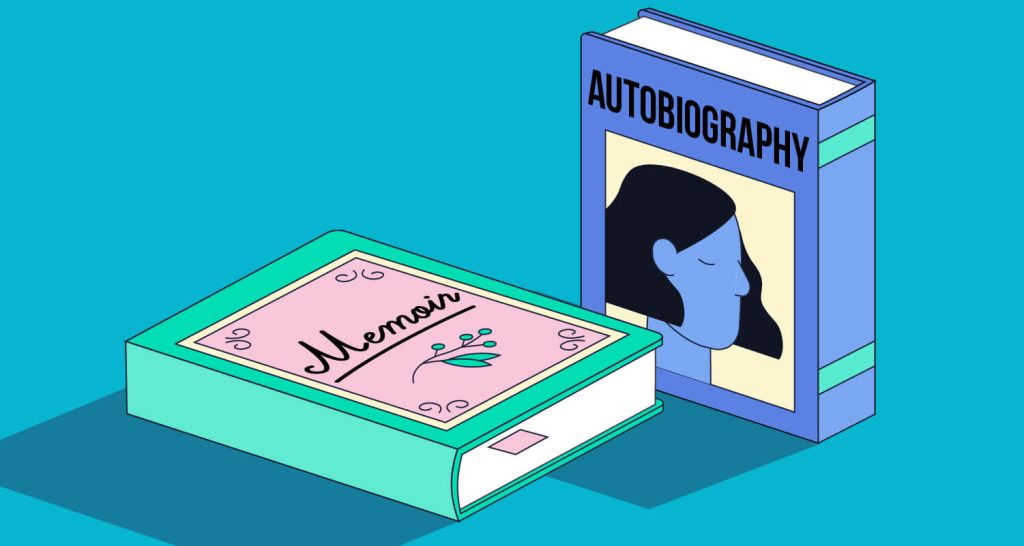The prose is generally of two types, i.e., fiction and non-fiction. Within these two categories of prose lie numerous genres of writing, such as novels, poetry, autobiographies, travel guides, etc. While fiction is more widely read than non-fiction, it is not the only category that sparks readers’ interest. There is a wide readership of non-fiction that enjoys reading different genres, especially autobiographies. People love reading about the lives of famous personalities and historical figures. In fact, the best autobiography examples are of people like Nelson Mandela, Steve Jobs, etc.
While reading autobiographies is entertaining, writing them is even more interesting. In this article, we have shared how to write a great autobiography with examples and samples of well-written autobiographies.
What is an Autobiography?
An autobiography can be defined as a non-fiction first-person account of the author’s own life. The subject writes about their life story from their own point of view in an autobiography.
Usually, autobiographies are quite a popular reading genre among the general public. Most of the time, autobiographies are on the top of bestseller lists.
Autobiography vs. Biography
In simple words, we can say that an autobiography is the subgenre of biographies. Generally, biographies are written by someone other than the subject of the biography. It is usually a historian who writes a biography. On the other hand, autobiographies are written by the subject as a firsthand account of their own life. In other words, autobiographies are more personal than a biography and offers more intimacy with the writer.
What to include in an autobiography?

Generally, an autobiography should contain all the important details from the life of the author. However, it doesn’t mean they add every single detail about their life in the account. They should be self-aware enough to only add in the moments that spark some emotion in the reader and not be a waste of space.
According to expert writers and best autobiography examples, an autobiography should contain the following six elements:
- Personal Origin Story
An autobiography must include a detailed account of the subject’s origin. It can include details like:
- hometown details
- family history
- description of key family members/loved ones/friends
- touchstone moments in education
- achievements in professional life
These are some of the most common elements included in the personal origin story. However, these are not the only details that can describe the subject’s origin.
- Remarkable Experiences
After explaining the origin story, the subject can go on to share significant experiences from their personal lives. They should choose those experiences that helped shape their worldview and approach towards life.
- Recollections of Professional Life
Besides the personal experiences, another element that makes an autobiography interesting is the detailed recollection of professional life episodes. In great autobiography examples, these episodes are usually the turning points for which readers remember the autobiography for years. These incidents are thrilling and inspirational and they intrigue the reader to begin reading in the first place.
- Personal Failure Story
An autobiography should not be filled with sunshine and rainbows. It should not solely focus on the subject’s success stories; rather it should also include some failure stories. Including a personal story of failure in an autobiography helps keep it real and more relatable. However, the writer should write the subject’s response to that failure in an inspirational and uplifting manner.
- An Eye-Catching Title
Before the reader reads anything inside the book, he/she will look at the title. So, the title should be attention-grabbing and compelling. Moreover, it should not be a generic phrase like the story of my life. The writer should pay attention to the title and make it as relatable to the story as possible while keeping it catchy.
- First-Person Narrative
Since an autobiography is a firsthand account of a person’s life, it must be written in the first-person narrative. Generally, biographies are written in third-person narrative, but the first-person narrative is more suitable for an autobiography.
How to Write an Autobiography?
According to experts, a writer should follow some steps for writing autobiographies. They have identified 8 steps for composing an excellent autobiography and below is a step-by-step guide for it:
- Brainstorming
The first step for writing an autobiography is brainstorming. During this step, the writer compiles all their significant life experiences that may be interesting enough for an autobiography. While brainstorming, the writer should cover all periods of their life from childhood to their current age. They should highlight the phase or period for which they are famous.
Writers should remember that everything they compile during brainstorming does not make it to the book’s final draft. However, the process helps create a clear outline according to their preference.
- Outlining
After getting all the needed content, the writer should start creating an outline for the autobiography. They should start by organizing a narrative around the most interesting episodes of their life. However, the strategic placement of these incidents is essential throughout the book. Otherwise, the reader will not be able to pay attention to every part of the book and lose interest.
Example of an Autobiography Essay Outline
- Researching
Research is an integral part of writing an autobiography. Although it is a personal account of the subject’s life, it should not include wrong information. The writer should research well about the details of a particular incident they report in their book. For this purpose, they should have discussions and interviews with people involved in that incident, their family members, and friends. These discussions can help them remember or correct the details that they may have forgotten or not remembered incorrectly.
- Writing the First Draft
Now that the research is done and the outline is created, it’s time to write the first draft. Generally, the first draft is not perfect or final. It is usually long with unnecessary or repetitive details and sometimes it is not even in the right order. However, the journey of a thousand steps always starts with the first step. So, since you have to start from somewhere, start long.
- Taking a Break
Writing is an exhaustive and mind-consuming activity. So, after completing the first draft, take a break from writing for a few days. It helps clear the mind and when you come back, you can read your work with a fresh perspective. As a result, you will be able to eliminate unnecessary details and improve the overall structure.
- Proofreading
After you resume the writing process, start with proofreading. During this stage, writers should look for grammatical errors, misspelled words, structural mistakes, etc. Besides these, you should also improve the weaker narrative points. You can take help from well-written autobiography examples to improve your work.
- Writing the Next Draft
After reading and proofreading the first draft with necessary corrections, the writer can start writing the second draft. This draft follows the notes taken during proofreading. After completing the second draft, the writer can hire a professional editor to improve their work. They can also take help from their trusted friends. Having external help can offer a fresh perspective that helps improve the work greatly.
- Refining
The first read from the editor or a friend will lead to a lot of notes and suggestions. The writer should critically analyze them and decide if they should be included. They can repeat this step until they think the draft is perfect. But until they are satisfied, they should keep refining the draft.
Writing an Autobiography – Sample

Autobiography Outline Examples
Below we have shared some autobiographies outline examples for students:
Sample Autobiography Outline

Autobiography Outline for College Students

Autobiography Examples
Below we have shared some autobiography examples for students:
Michael Smith’s Short Autobiography

Evan Cary’s Short Autobiography

In a Nutshell
This article has discussed what autobiographies are and how to write them. Moreover, there are writing tips as well as examples and samples for writing autobiographies. Using these autobiography examples, students can easily write a perfect autobiography for their assignment writing as well as professionally.


